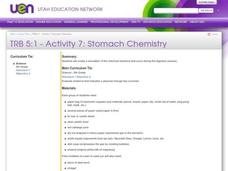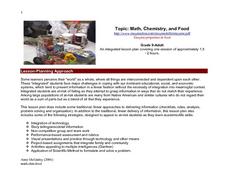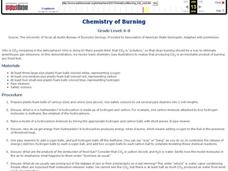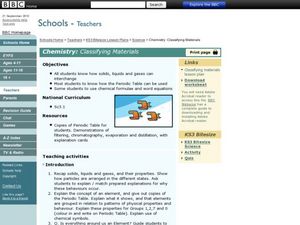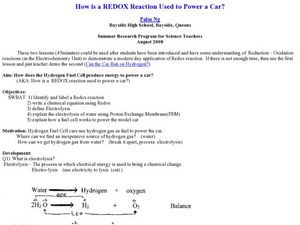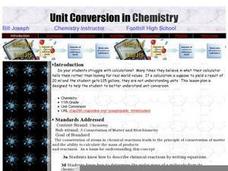Curated OER
Elements of Chemistry: Compounds And Reactions
Learners identify substances and discover common substances and their chemical composition. In this chemistry lesson students write a description of the substances and how they are used.
Curated OER
Le Chatelier's Principle
In this chemical equilibrium worksheet, students review Le Chatelier's Principle and predict the direction of equilibrium shift for different changes to a chemical reactions. Students also review enthalpy and entropy. This worksheet has...
Utah LessonPlans
Stomach Chemistry
Students will create a simulation of the chemical reactions that occur during the digestive process. A physical change occurs when the appearance of matter changes, but the composition of the matter does not change.
Curated OER
Topic: Math, Chemistry, and Food
Students listen as the teacher tells the story of Sisyphus rolling the stone up the mountain. Students prepare two batches of jello, one with fresh pineapple, and one with canned pineapple. While the jello is setting, students work on...
Curated OER
Alka-Seltzer Cannons
Fourth graders observe what is happening when an Alka-Seltzer tablet is placed in a clear cup of water. They observe the release of carbon dioxide gas. Pupils answer the question of how much as is released by observing the experiment...
Curated OER
Acids and Bases: Their Reactions, Conductivity, Base Indicators and Neutralization Reaction
Students conduct experiments and collect data to determine physical and chemical characteristics of acids and bases.
Curated OER
The Stoichiometry Behind Pollution
Students research car emissions of various cars and find the toxins emitted. In this stoichiometry lesson, students calculate the relationship between reactants and products in a chemical reaction. Students collect data on emissions and...
Curated OER
Introducing Chemistry Vocabulary
Students study vocabulary based on chemistry terms by creating flash cards. In this scientific vocabulary lesson plan, students utilize a chemistry word or phrase to create a card which uses the term, describes it in the student's...
Curated OER
The Right Chemistry
Students see that chemistry is the study of matter, how matter reacts and combines to create new chemicals, the changes that take place in matter and what makes up matter. This lesson plan provides many good ideas across the curriculum...
Curated OER
Chemical Equilibrium
Middle schoolers explore Le Chatelier's Principle. In this lesson about chemical equilibrium, students do an experiment with several different activities . Middle schoolers observe as they do the experiments and understand the outcome....
Curated OER
Precipitation and Neutralization Reactions
In this chemical reactions worksheet, students determine the balanced formula equation, balanced complete ionic equation, and the balanced net ionic equation for given reactions. Students calculate final concentrations for ions in given...
Curated OER
Chemistry of Burning
Students look into the increase of carbon dioxide in the atmosphere. In this chemistry lesson, students look at the hydrocarbon molecule through a model and see what happens when energy is released. They watch as the water vapor leaves...
Cornell University
The Galvanic Cell Game
Play a little game with your classes! Young scholars expand on their understanding of oxidation/reduction reactions in a game-based activity. They build a Galvanic cell with game pieces while learning about each component and their...
Curated OER
Don't Be Tricked By Your Integrated Rate Plot
In this chemistry worksheet, young scholars examine the given concept in order to apply in the laboratory setting. The sheet includes in depth background information.
Virginia Department of Education
Acid-Base Theory
Litmus paper, why so blue? A chemistry lesson includes a pre-lab activity, practice calculating pH, an experiment measuring the pH in acids and bases, a titration demonstration, and a titration experiment.
Curated OER
Ammonium Nitrate - Heat of Solution
Students quantify the relationship between temperature, energy and heat
and define an endothermic reaction. They measure the energy change caused by dissolving one mole of ammonium nitrate in water.
Curated OER
Alka Rockets! An Introduction to Kinetics
Students identify the factors that influence reaction rates. In this chemistry lesson plan, students design an experiment to test one factor they identified. They perform the experiment and share the results to the entire class.
Curated OER
The Chemistry of Lead
Learners explore the basic concept of physical and chemical properties of the element lead, as well as its historical and modern day uses, and how and why it is toxic to the human body. They are shown the basic reactions of the element...
Curated OER
Chemistry: Classifying Materials
Students classify materials. In this chemistry lesson, students examine the properties of solids, liquids, and gases. Students discover the elements, compounds, and chemical symbols.
Curated OER
Physical or Chemical- That Is the Question!
Learners differentiate physical and chemical changes. For this chemistry lesson, students give examples of each type of change. They take the review quiz at the end of the lesson.
Curated OER
Chemistry: Metals and Non-Metals
Students conduct an experiment to test the reactivity of metals and non-metals. In this chemistry instructional activity students test metals with different chemicals to observe the reaction. The results are used to categorize the metals.
Curated OER
How is a REDOX Reaction Used to Power a Car?
Students explore electrolysis and Redox reactions. For this exploratory lesson students demonstrate an example of electrolysis and how it brings on a chemical change.
Curated OER
Unit Conversion in Chemistry
Hopefully by the time high schoolers are enrolled in your chemistry class, they are skilled with unit conversion. It does not hurt, however, to take an hour early in the school year to review this vital skill. This plan simply provides a...
Curated OER
Physical and Chemical Changes
Eighth graders distinguish between physical and chemical change. For this chemistry lesson, 8th graders observe a series of demonstrations showing physical and chemical changes. They identify the signs that a chemical reaction took place.




